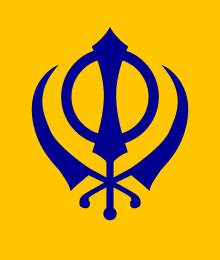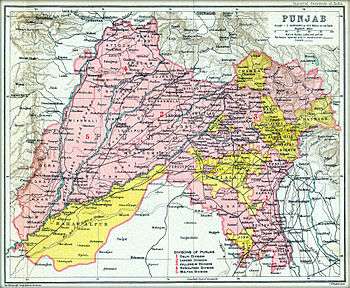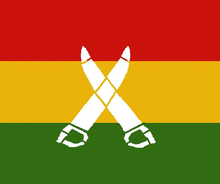Outline of Sikhism
The following outline is provided as an overview of and topical guide to Sikhism:

Sikhism – monotheistic religion founded in the fifteenth century upon the teachings of Guru Nanak and ten succeeding Gurus (the last one being the sacred text Guru Granth Sahib), emphasizing universal, selfless love and brotherhood. "Only those who selflessly love everyone, they alone shall find God". Guru Granth Sahib teaches the humans how to unite with the all cosmic soul, with the creator. It is the fifth-largest organized religion in the world[1] and one of the fastest-growing.[2]
Sikh scripture
- Gurbani (General term for Guru's writings)
- Guru Granth Sahib
- Nitnem (Daily recitations)
- Japji Sahib (First composition of the Guru Granth Sahib)
- Asa Di Var - 24 stanzas used as a morning prayer
- Sukhmani Sahib - A popular set of hymns in the Guru Granth Sahib divided into 24 sections
- Laavaan - The four hymns of the Anand Karaj or wedding ceremony
- Sawayya - One of the morning prayers.
- Rehras - The evening prayer
- Tav-Prasad Savaiye
- Varan Bhai Gurdas
Sikh religious philosophy
Sikh philosophy
- Three pillars of Sikhism
- Sikh beliefs
- Meditation
- Grihastha
- Seva
- Guru Maneyo Granth
- Sikh Rehat Maryada – Code of conduct
- Prohibitions in Sikhism
- Bhakti
- Shakti
- Advaita or Non Dualism/ Monism
Sikh Practices
- Simran
- Selfless service (Sewa)
- Nāma –
- Naam Karan –
- Naam Japo –
- Five Thieves –
- Five Virtues
- Sikh Rehat Maryada –
- Nanakshahi calendar –
- Ardās –
- Amrit – elixir of immortality - the sanctified nectar or sugar water substitute used in ceremonies. It is prepared by stirring it in an iron bowl with the double-edged sword and continuous recitation of five banis by the five selected members of the Khalsa.
- Anand Karaj – Sikh marriage ceremony, meaning "Blissful Union" or "Joyful Union". It was introduced by Guru Amar Das.
- Antam Sanskar –
- Kirtan – call-and-response chanting
- Langar – communal kitchen where free food is distributed to all comers
- Charhdi Kala –
- Dasvand
Sikh ceremonies
- Naam Karan - Child's naming ceremony
- Amrit Sanchar – Baptism into the Khalsa tradition
- Akhand Path Continuous reading of Sri Guru Granth Sahib
- Anand Karaj - Wedding ceremony
- Antam Sanskar - Funeral rites
Sikh festivals
- Bandi Chhor Divas A celebration during Diwali
- Vasakhi A festival during late Spring
- Gurpurab A celebration a Guru's birth
Sikh geography



- Akal Takhat (Eternal Throne) - Nominal seat of Sikh temporal/political authority.
- Amritsar – city of 1.5 million in the northwestern part of India. It is home to the Harmandir Sahib, known as the Golden Temple, the spiritual and cultural center of the Sikh religion.
- Anandpur or Anandpur Sahib – Birthplace of the Khalsa
- Patna Sahib
- Goindval Sahib
- Harmandir Sahib - Holy shrine of the Sikhs in the holy city of Amritsar.
- Kartarpur - Seat of Guru Nanak's first school.
- Nankana Sahib – Birthplace of Guru Nanak
- Samadhi of Ranjit Singh –
Sikhism by country
Gurdwaras
Category:Gurdwaras
- Harimandir Sahib
Gurdwaras in India
- Gurdwaras in India
- Gurdwara Bangla Sahib
- Gurdwara Sri Tarn Taran Sahib
- Goindval Sahib
- Harmandir Sahib - Holy shrine of the Sikhs in the holy city of Amritsar.
Gurdwaras in Canada
- Gurdwaras in Canada
Gurdwaras in the United States
- Gurdwaras in the United States
- Gurdwara Sahib Fremont
- Sikh Gurdwara - San Jose
- Sikh Gurdwara of San Francisco
- Sikh Religious Society of Chicago
Gurdwaras in Pakistan
- Gurdwaras in Pakistan
- Kartarpur - Seat of Guru Nanak's first school.
- Nankana Sahib – Birthplace of Guru Nanak
Gurdwaras in Hong Kong
Gurdwaras in Malaysia
Gurdwaras in Singapore
- Central Sikh Temple
- Gurdwara Sri Guru Singh Sabha
Sikh politics

- Akali movement
- All India Sikh Students Federation
- Babbar Akali –
- British Sikh Student Federation
- Delhi Sikh Gurdwara Management Committee
- Khalistan movement – Separatist movement[3][4] to create a Sikh homeland, often called Khālistān (Punjabi: ਖ਼ਾਲਿਸਤਾਨ, Hindi: ख़ालिस्तान "The Land of the Pure"), in the Punjab region of India and Pakistan[5][6]
- Ghadar Party
- Punjab Janata Morcha –
- Sarb Hind Shiromani Akali Dal –
- Singh Sabha Movement
- Shiromani Akali Dal –
- Haryana State Akali Dal –
- Shiromani Akali Dal (Democratic) –
- Shiromani Akali Dal (Longowal) –
- Shiromani Akali Dal (Panthik) –
- Shiromani Akali Dal (Simranjit Singh Mann) –
- Shiromani Akali Dal Delhi –
- World Sikh Organization
History of Sikhism
- Akali movement
- 1984 Sikh Genocide - November 1984
- Amritsar Massacre (Jalianwalla Bagh Massacre) - April 13, 1919
- Battle of Saragarhi - Famous battle
- First Anglo-Sikh War - 1845–1846
- History of the Punjab
- Operation Blue Star (Sikh Genocide) - June 1984
- Second Anglo-Sikh War - 1848–1849
- Sikh holocaust of 1762
- Sikh holocaust of 1746
- Sikh Confederacy –
- Sikh Empire –
- Sukerchakia –
- Khalsa Sajana Divas
Sikh culture
- Punjabi language
- Sikh Festivals
- Sikh names
- Turban
Sikh people

- Sikhs - article focused on Sikh society
- List of Sikhs
- Amritdhari – baptized Sikh who has undergone the Khalsa ceremony. According to Sikh Reht Maryada, any person who is initiated into the Khalsa is called Amrit Dhari.
- Sahajdhari - unbaptized Sikh.
- Nihang - Sikhs who consume Bhang (cannabis sativa), opium and other narcotics to assist in meditation.
- Panj Pyare or Panj Piare (literally the five beloved ones) - title given to five Sikhs by Guru Gobind Singh at the historic divan at Anandpur Sahib on 30 March 1699 and who formed the nucleus of the Khalsa as the first batch to receive at his hands khanda di Pahul, i.e. rites of the two-edged sword.
- Bhai Daya Singh –
- Bhai Dharam Singh –
- Bhai Himmat Singh –
- Bhai Mohkam Singh –
- Bhai Sahib Singh –
Sikh Gurus
- Sikh Gurus –
- Guru Nanak Dev[7]
According to the traditional historical Sikh sources Guru Nanak Dev appeared on earth in the month of Katak Oct/November 1469 which is celebrated every year in the month of October/November. The SGPC which was found in 1925, they state the avtar date as of 15 April 1469 – 22 September 1539) – founder of the Sikh faith and the first of the ten Sikh Gurus. The Sikhs believe that all subsequent Gurus possessed Guru Nanak’s divinity and the one spirit of Akaal Purakh Waheguru.
- Guru Angad Dev (1504 – 1552) – disciple of Guru Nanak Dev and second of the ten Sikh Gurus.
- Guru Amar Das (1469 – 1574) – third of the ten Sikh Gurus.
- Guru Ram Das ( 1534 – 1581) – fourth of the ten Sikh Gurus.
- Guru Arjan Dev (1563 – 1605) – fifth of the ten Sikh Gurus, He was arrested and executed by Jahangir in 1605.[8]
- Guru Har Gobind (1596 – 1638) – son of Guru Arjan Dev and the sixth of the ten Sikh Gurus.
- Guru Har Rai (1630 – 1661) – grandson of Guru Har Gobind and seventh of the ten Sikh Gurus.
- Guru Har Krishan (1656 – 1664) – son of Guru Har Rai and eighth of the ten Sikh Gurus.
- Guru Tegh Bahadur (1621 – 1675) – grand uncle of Guru Har Krishan and ninth of the ten Sikh Gurus. He was executed on the orders of Mughal Emperor Aurangzeb in Delhi.[9]
- Guru Gobind Singh(1666-1708) – son of Guru Tegh Bahadur and tenth of the ten Sikh Gurus, He named the holy scripture, as his successor
- Guru Granth Sahib – the spiritual religious text of Sikhism, said to be the sole and final successor of the line of gurus. It is the eternal living Guru.[10] the final and eternal guru of the Sikhs.[11]
Other esteemed Sikh individuals
- 1400-1499
- Bhai Mardana – Guru Nanak's constant Muslim companion, musician, and composer of Sikh hymns.
- Bhai Lalo –
- Bibi Nanki - Guru Nanak's sister and often considered his first disciple.
- Sri Chand - Guru Nanak's son and founder of an early Sikh sect.
- 1500-1599
- Baba Buddha Ji - One of the most revered Sikh saints and anointer of several of the early Sikh Gurus.
- Bhai Gurdas - One of the most revered Sikh saints and writer of the Vars.
- Bhai Bala –
- Mian Mir –
- 1600-1699
- 1700-1799
- 1800-1899
- Akali Phula Singh
- Baba Nand Singh ji –
- Maharajah Ranjit Singh –
- Nawab Kapur Singh –
- Baba Ram Singh
- Pundit Tara Singh
- 1900-1999
- Baba Gurdit Singh –
- Bhagat Puran Singh –
- Bhai Randhir Singh –
- Bhai Kahn Singh Nabha –
- Bhai Vir Singh –
- G. B. Singh –
- Giani Gurdit Singh –
- Giani Sant Singh Maskeen –
- H. S. Phoolka –
- Ishar Singh –
- Sant Baba Harnam Singh Ji –
Sikh education
Sikh humanities
Sikh literature
Category:Sikh literature
- Janamsakhi (non-canonical history of Guru Nanak)
- Bala Janamsakhi - A collection of janamsakhis by Bhai Bala (generally accepted as authoritative).
- Mani Singh Janamsakhi or Gyan ratanavali - A collection dating from the time of the last Guru.
- Miharban Janamsakhi - Janamsakhis written by the followers of Prithi Chand.
- Puratan Janamsakhi - An early collection of janamsakhis by an unknown author.
- Suraj Parkash (non-canonical Sikh history)
- Prachin Panth_Parkash (non-canonical Sikh history)
- Varan Bhai Gurdas (early edition of the Sikh concepts and living, written down by Bhai Gurdas)
- Zafarnama - Letter by Guru Gobind Singh to Aurangzeb
General concepts
- Bani – verses. An abbreviation of Gurbani, applied to any of the writings which appear in the Guru Granth Sahib.
- Brahmgiani – highly enlightened individual who has obtained the ultimate blessings of Waheguru.
- Brahmavidya – Knowledge of the divine
- Bhagat Bani – Any of the writings which appear in the Guru Granth Sahib which were not written by the Gurus.
- Daan – Charity. One of the 3 petitions - Naam, Daan, Ishnan.
- Dasband (daswand) – 10% of earnings donated to the less advantaged.
- Dastar – Turban (Pugree). It is an inseparable part of Sikh dress and is mandatory for a Sikh to tie his turban according to Sri Guru Granth Sahib and the Sikh 'Code of Conduct'.
- Dharam di Kirat – to earn an honest living.
- Diet in Sikhism
- Ek Onkar –
- Gatka – Sikh martial art
- Gurbani – Collective writings of the Sikh Gurus. (See bani.)
- Gurdwara, gurudwara – Place of worship, meaning "God's door", or God's place
- Gurmukh – Person who is spiritually centered. (See manmukh.) A person who lives within the will of God and accepts all good and bad that happens to one's self without question or annoyance.
- Gurmukhi – The written form of Punjabi used in the Sikh scriptures propagated by Guru Nanak and Guru Angad. Gurmukhi script is also called 'Paintis Akhri' because it contains thirty-five letters.
- Harmandir Sahib –
- History of the Punjab
- Ik Onkar –
- Ishnan – Purity of mind and body. One of the three petitions - Naam, Daan, Ishnan.
- Jap – Recite.
- Japji Sahib – The first 8 pages of the Siri Guru Granth Sahib (Sikh holy scripture), consisting of hymns composed by Guru Nanak.
- Jayadeva in Sikhism - Wrote two hymns that are in the guru granth.
- Kakke – Panj (5) K's that must be worn by Sikhs.
- Kaur – Princess. Female Sikh middle name or surname
- Khalsa – Pure - must carry panj kakkar
- Khalsa Panth –
- Khanda - A symbol of the Sikh faith (as well as being an Indian-double edged sword); also appearing on the Nishan Sahib which flies over gurdwaras.
- Kirat karō (kirat karni) – One of the three primary pillars of Sikhism, the others being Naam Japo and Wand kay Shako. The term means to earn an honest, pure and dedicated living.
- Kirtan –
- Kurahit kurahat – The cardinal sins for the Sikhs. These are cutting, trimming, shaving or removing hairs from one’s body, eating kuttha meat, using tobacco or any other intoxicant in any form or committing adultery.
- Laavaan –
- Manmukh – A self-centered person, contrast gurmukh. A person who lives within the will of the Mind as opposed to the will of god.
- Mela Maghi –
- Mul Mantra – Basic statement of creed.
- Naam – Name. Remembrance of the divine name.
- Nām Japō, Naam japna – Recitation and meditation on the Naam of the Lord.
- Nanakshahi calendar –
- Nirankari –
- Nitnem – Daily prayers which begin with Japji Sahib and are written in a Gutka (prayerbook).
- Panj dokh – The 5 thieves/betrayers. Ahankar (pride), Kam (lust), Krodh (anger), Lobh (greed) and Moh (worldly attachment)
- Panj Kakke – The Five K's; the five external symbols worn by both male and female Sikhs. The name of each symbol starts with the letter k (kakka); kaccha, kanga, kara, kesh and kirpan.
- Panj virtues – Daya (compassion), Nimrata (humility), Pyaar (love), Santokh (contentment) and Sat (truth).
- Panj weapons – Chardi Kala (positive energy), Daan (charity), Dayan (kindness) Nimarta (humility), Santokh (contentment)
- Panj – The number 5
- Patit – Apostate
- Sangat – Society (congregation) see Panth.
- Sarbat da Bhalla – Welfare of mankind (sarbat = mankind, bhalla = welfare)
- Sarbloh Warriors - a computer game based around Sikh resistance against Mughal rule
- Sardar –
- Satguru –
- SGPC (Shiromani Gurudwara Prabhandak Committee) –
- Shabad, Śábda – The hymns contained in Sikh scriptures.
- Shaheed – Title used before the name of a person who has died as a Sikh martyr.
- Sikh –
- Sikh Bhagats –
- Sikh Empire –
- Sikh Light Infantry –
- Sikh Regiment –
- Simran – Simran is the remembrance of Waheguru. Guru Nanak formed a new type of Bakti beginning with Simran and Jap of Waheguru Gurmantar.
- Singh Sabha –
- Singh – Lion. Male Sikh middle or surname title.
- Sloka – Stanza. The Sanskrit epic metre formed of thirty-two syllables – verses of two lines (distich) of sixteen syllables each or in four half-lines (hemistich) of each syllables each. Japu (recitation) comprises an introductory sloka, 38 stanzas traditionally called pauris and a concluding sloka attributed by some to Guru Angad.
- Sukhmani – the Psalm of Peace.
- Takht
- Takhat –
- Tankhah – Salary, payment also social offense - He is not to commit any of the social offences (Tankhah), such as giving dowry, using liquors and intoxicants, raising monuments over graves and associating with apostates.
- Turban – Dastar (Pugree). It is an inseparable part of Sikh dress and is mandatory for a Sikh to tie his turban according to Sri Guru Granth Sahib and the Sikh 'Code of Conduct'.
- Udasis –
- Waheguru (ਵਾਹਗੁਰੂ) – Wondrous enlightener, illuminator lord, which removes the darkness of ignorance and grants the light of
truth, knowledge and awareness.
See also
- Glossary of Sikhism (alphabetical)
- Interfaith dialog
References
- Adherents.com. "Religions by adherents" (PHP). Retrieved 2007-02-09.
- "The List: The World's -Growing Religions". Foreign Policy. Foreign Policy. Archived from the original on 26 May 2012. Retrieved 5 November 2010.CS1 maint: BOT: original-url status unknown (link)
- Colonist, Times (2008-03-11). "Sikh separatists in Canada concern Indian government". Canada.com. Retrieved 2010-01-22.
- "25 years on, few takers for Khalistan in Canada". Thaindian.com. Retrieved 2010-01-22.
- The foreign policy of Pakistan: ethnic impacts on diplomacy, 1971–1994. ISBN 1-86064-169-5. Mehtab Ali Shah: "Such is the political, psychological and religious attachment of the Sikhs to that city that a Khalistan without Lahore would be like a Germany without Berlin."
- Amritsar to Lahore: a journey across the India-Pakistan border. Stephen Alter. ISBN 0-8122-1743-8 "Ever since the separatist movement gathered force in the 1980s, Pakistan has sided with the Sikhs, even though the territorial ambitions of Khalistan include Lahore and sections of the Punjab on both sides of the border."
- Guru Nanak may be referred to by many other names and titles such as "Satguru Nanak Dev", "Guru Nanak Dev" or "Baba Nanak" .
- N. Jayapalan (2001). History of India. Atlantic. p. 160. ISBN 978-81-7156-928-1.
- A Gateway to Sikhism | Sri Guru Tegh Bhadur Sahib J - A Gateway to Sikhism Archived 2008-08-30 at the Wayback Machine
- Deol, Harnik (2000). Religion and Nationalism in India. Routledge. p. 62. ISBN 0-415-20108-X.
- Keene, Michael (2003). Online Worksheets. Nelson Thornes. p. 38. ISBN 0-7487-7159-X.
External links
- Sikh History Web Portal
- Sikh Philosophy Network An Online Sikh Discussion Forum
- Sikh-heritage.co.uk

